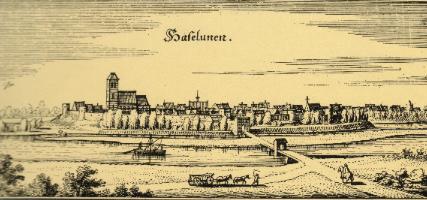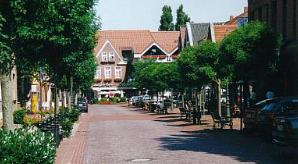|
History of Haselünne
Haselünne is the eldest town of the Emsland. German tribes, called “Chasuarier” by the Romans, used a place with shallow water to cross the river Hase. Oak trunks rolled into the riverbed served as underground. In the old saxon language, these trunks were called lunni or lünne. The trunks together with the Name of the River formes the name of the town.
As far as we know, the town startet with a small saxon settlement . The biggest farm (german:Hof) was on a place called “Hofstätte”, today a parking area. Missionaries from Utrecht bildt the first wooden church on this place about the year 800.
Around this church soon flocked the wooden houses of craftsmen and traiders. In the year 834 Ludwig the faithful donated the whole possessions of the church of Haselünne to the Corvey monastery. Under Corveyan management Haselünne became a fortified “wigbold” (saxon traiding center). That meant, the people living there were able to buy their own landes property and make it hereditary.
The monastery of corvey was represented by the earls of Zütfen, wo soon seized the opportunity to make the town their own. When the title “earl of Zütfen” became extinct ( because no male heir survived ), Haselünne went by the female line to the Earls of Ravensberg . Now the citadel of Ravensberg, the “Burg tho Lünne”, formed the town center, just above the old flamish traiding route and military highway at the crossing of the river Hase. . Now the citadel of Ravensberg, the “Burg tho Lünne”, formed the town center, just above the old flamish traiding route and military highway at the crossing of the river Hase.
About the year 1220 Haselünne was declared a town with rights of market , customs examination and coining.
The last countess of Ravensburg, countess Jutta, annoyed by territorial claims of the robber-knights of Schwarzenberg , called the bishop of Osnabrück for help. The bishop declined, and countess Jutta now asked Bishop Gerhard of Münster. For his support and money in the year 1252 he got the territorial rights of all the Ravensburg holdings , Haselünne included.,
Bishop Gerhard confirmed the freedom of the city on March 25. ,1272. Therafter Haselünne got walls and fortifications. The cidatel “ Burg tho Lünne “, placed on the “ Hopfenmarkt”, now lay inside of the town-walls. Thus it became unseless for defence. The citizens of Haselünne used the old citadel as a quarry untill it vanished completely.
Of the 22 smaller strongholds of the town, the “ Burgmannshöfe “, managed by the local gentry, only 10 survived the city-walls. They probably looked like small fortresses with palisades all around. Four of them were situated on the northern side of the town ( the river Hase flows at the southern side ), three on the “Ritterstraße “ (Knights street), as well in the north, but more central, one next to the western gate of the town the “ Steintor” (stone gate), one near the eastern side of the walls, and the last next to the street crossing the river Hase, the “Hasestraße”.
About half of them still exist today, often altered or rebuild, all of them in recent times taken over by non-gentry citizens and merchants. The most impressiv stronghold today is the “Westerholt´scher Burgmannshof”, still looking fortress-linke, now part of the destillery Berentzen . ( You will find a foto on our picture-page).
.........to be continued........
|



